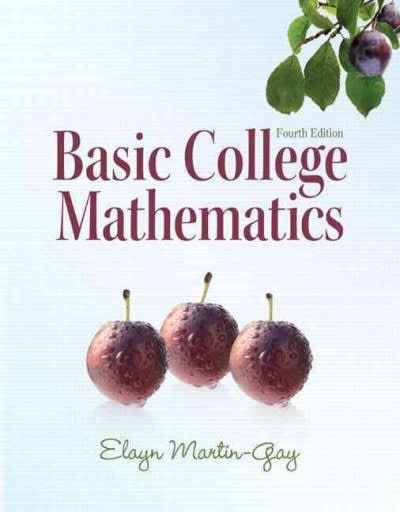Question
Fuel economy estimates for automobiles built one year predicted a mean of 24.2 mpg and a standard deviation of 6.8 mpg for highway driving. Assume
Fuel economy estimates for automobiles built one year predicted a mean of
24.2
mpg and a standard deviation of
6.8
mpg for highway driving. Assume that a Normal model can be applied. Use the
689599.7
Rule to complete parts a) through e).
| a) | Draw the model for auto fuel economy. |
A.
17.4
10.6
3.8
37.8
31
44.6
24.2
68%
95%
99.7%
A bell-shaped curve with horizontal axis from less than 3.8 to 44.6 plus in intervals of 6.8 begins just above the horizontal axis, increases at an increasing and then decreasing rate to its maximum at 24.2, and decreases at an increasing and then decreasing rate approaching the horizontal axis. The curve is symmetric. The area below the curve is subdivided into regions by the intervals and labeled as follows: from 17.4 to 31, "68%"; from 10.6 to 37.8, "95%"; from 3.8 to 44.6, "99.7%."
B.
17.4
10.6
3.8
51.4
37.8
65
24.2
68%
95%
99.7%
A bell-shaped curve with horizontal axis from less than 3.8 to 65 plus begins just above the horizontal axis, increases at an increasing and then decreasing rate to its maximum at 24.2, and decreases at an increasing and then decreasing rate approaching the horizontal axis. The seven equidistant horizontal axis labels are as follows from left to right: 3.8, 10.6, 17.4, 24.2, 37.8, 51.4, 65. The curve is visually symmetric. The area below the curve is subdivided into regions by the intervals and labeled as follows: from 17.4 to 37.8, "68%"; from 10.6 to 51.4, "95%"; from 3.8 to 65, "99.7%."
C.
20.8
17.4
14
31
27.6
34.4
24.2
68%
95%
99.7%
A bell-shaped curve with horizontal axis from less than 14 to 34.4 plus in intervals of 3.4 begins just above the horizontal axis, increases at an increasing and then decreasing rate to its maximum at 24.2, and decreases at an increasing and then decreasing rate approaching the horizontal axis. The curve is symmetric. The area below the curve is subdivided into regions by the intervals and labeled as follows: from 20.8 to 27.6, "68%"; from 17.4 to 31, "95%"; from 14 to 34.4, "99.7%."
| b) | In what interval would you expect the central 99.7% of autos to be found? |
Using the 68-95-99.7 rule, the central
99.7%
of autos can be expected to be found in the interval from
enter your response here
to
enter your response here
mpg.
(Do not round. Type integers or decimals.)
| c) | About what percent of autos should get more than 31 mpg? |
Using the 68-95-99.7 rule, about
enter your response here%
of autos should get more than
31
mpg.
(Do not round. Type an integer or a decimal.)
| d) | About what percent of autos should get between 31 and 37.8 mpg? |
Using the 68-95-99.7 rule, about
enter your response here%
of autos should get between
31
and
37.8
mpg.
(Do not round. Type an integer or a decimal.)
| e) | Describe the gas mileage of the worst 2.5% of cars. |
Choose the correct answer below.
A.
They get more than
31
mpg.
B.
They get
less
than
10.6
mpg.
C.
They get less than
17.4
mpg.
D.
They get
less
than
3.8
mpg.
Step by Step Solution
There are 3 Steps involved in it
Step: 1

Get Instant Access to Expert-Tailored Solutions
See step-by-step solutions with expert insights and AI powered tools for academic success
Step: 2

Step: 3

Ace Your Homework with AI
Get the answers you need in no time with our AI-driven, step-by-step assistance
Get Started


